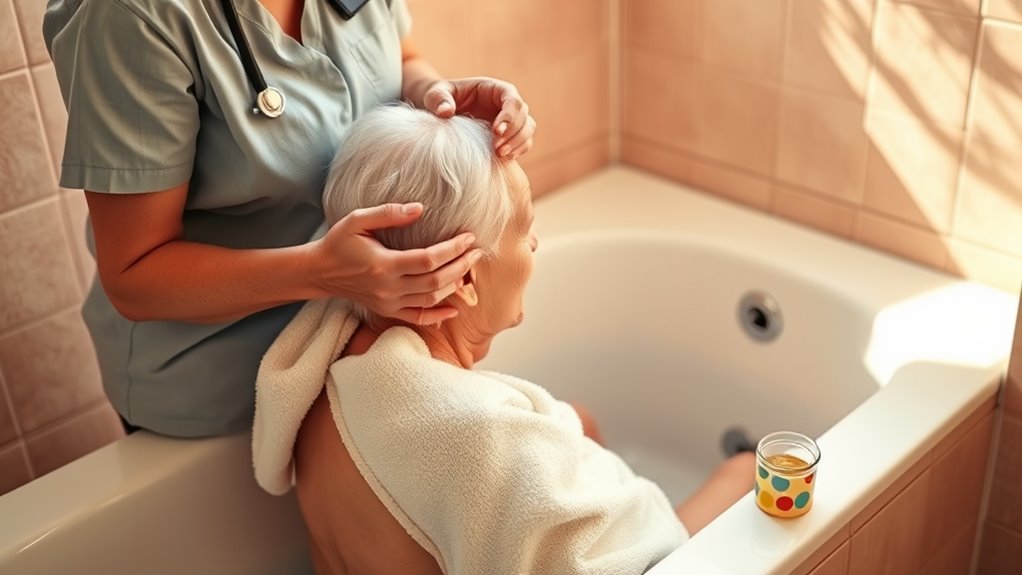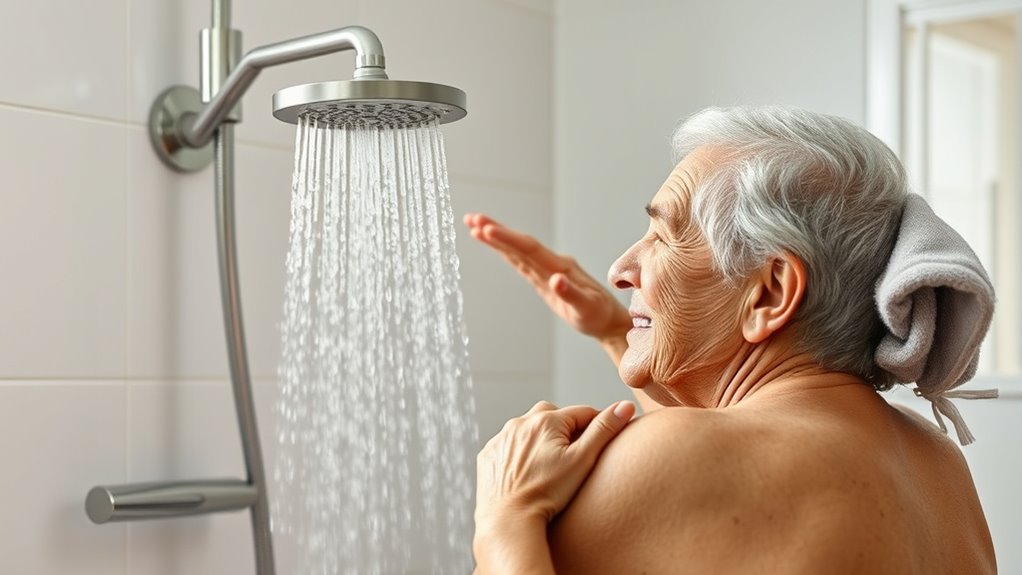Helping seniors with bathing and grooming involves creating a safe, comfortable environment and supporting their independence. Use gentle products suitable for sensitive skin, test water temperature, and always support their body securely. Install grab bars, use non-slip mats, and consider shower chairs to prevent falls. Regularly check their skin for irritation, keep nails trimmed, and assist with oral hygiene. To learn simple techniques that promote both safety and dignity, continue exploring effective caregiving tips.
Key Takeaways
- Use gentle, moisturizing products and test water temperature to protect sensitive skin during bathing.
- Install safety features like grab bars, non-slip mats, and shower chairs to ensure stability and prevent falls.
- Support the senior securely, maintain clear communication, and be patient throughout grooming and hygiene routines.
- Regularly inspect the skin for irritation, pressure sores, or breakdown, and adjust routines accordingly.
- Keep hair tidy, trim nails, and maintain oral hygiene to promote overall personal cleanliness and confidence.

Bathing and grooming are essential parts of maintaining your overall health and well-being. For seniors, staying clean and well-groomed isn’t just about appearance; it’s a vital aspect of health that can prevent infections and boost confidence. If you or a loved one face mobility challenges, these routines can become more complicated, but with the right approach, you can ensure safety and comfort. One of the main concerns when assisting with bathing is skin protection. As we age, our skin becomes thinner, more fragile, and prone to bruising or irritation. It’s important to use gentle, moisturizing products and avoid harsh soaps that strip natural oils. Always test the water temperature before bathing to prevent burns and discomfort, especially if sensation is diminished.
Prioritize gentle products and water testing to protect fragile, aging skin during bathing routines.
When mobility challenges are present, traditional bathing setups might not be feasible. You may need to adapt the environment by installing grab bars, non-slip mats, or a shower chair. These modifications help provide stability and reduce the risk of falls. If standing for long periods is difficult, a handheld showerhead allows you to control water flow easily and direct it where needed, making the process more manageable and less tiring. Remember to support the person’s body securely, using towels or cushions if necessary, to prevent strain or injury. Proper home safety measures and adjustments can significantly enhance the bathing experience and reduce risks. Additionally, considering age-related skin changes can guide the selection of suitable bathing products and techniques. Proper water temperature regulation is also crucial to avoid thermal injury and ensure comfort during bathing routines. Being mindful of skin sensitivity helps prevent irritation and discomfort during cleansing. Regularly inspecting the skin for signs of irritation or breakdown can further prevent complications.
Grooming routines also require special attention. Keeping hair tidy, trimming nails, and maintaining oral hygiene are crucial for overall health and comfort. For those with limited mobility, electric clippers or nail care kits designed for easy use can make these tasks less frustrating. When it comes to skin protection, be cautious around areas prone to pressure sores or skin breakdown, such as bony prominences. Regularly check these areas for redness, irritation, or wounds, and adjust positioning or padding as needed. Applying moisturizer after bathing helps keep the skin supple and resilient. Incorporating routine skin checks into daily care can help identify issues early and prevent further complications.
Throughout the process, communication is key. If you’re helping someone with mobility challenges, explain each step and ask about their comfort level frequently. Patience and gentle handling can make a significant difference in turning what might seem like a daunting task into a manageable routine. By being attentive to skin protection and making necessary adaptations, you ensure that bathing and grooming remain safe, dignified, and beneficial parts of daily life. Proper hygiene isn’t just about cleanliness—it’s about supporting health, building confidence, and preserving independence for as long as possible.
Frequently Asked Questions
How Can I Encourage Seniors to Maintain Their Hygiene Routines?
To encourage seniors to maintain their hygiene routines, use motivational strategies that highlight the benefits and foster a positive attitude. Establish routine scheduling to create consistency and make hygiene activities part of their daily rhythm. Offer gentle reminders, praise their efforts, and involve them in planning their routine. Your encouragement helps build independence and confidence, making it easier for seniors to stay motivated and maintain good personal hygiene habits daily.
What Are Safe Alternatives for Seniors With Mobility Issues?
Remember, “a little help goes a long way.” For seniors with mobility issues, safe alternatives like adaptive bathing and grooming aids can make a big difference. You can use walk-in showers, shower chairs, or handheld showerheads to guarantee safety. Grooming aids like long-handled sponges or electric razors allow independence. These options help seniors stay hygienic without risking falls or injuries, keeping them comfortable and confident.
How Do I Handle Resistance From Seniors During Grooming?
When seniors resist grooming, your goal is to ease their discomfort through emotional support and effective communication techniques. You should stay calm, listen carefully, and validate their feelings, showing patience and understanding. Use gentle explanations to clarify procedures and offer choices when possible. Building trust helps reduce resistance, making grooming a more positive experience. Your empathy and clear communication create a supportive environment that encourages cooperation and respects their dignity.
What Signs Indicate a Senior Needs Professional Grooming Help?
When evaluating if a senior needs professional grooming help, look for signs of neglect and personal hygiene decline. You might notice persistent body odor, unkempt hair, dirty nails, or stained clothing. These signs suggest they can’t manage grooming tasks alone. If you see these indicators, it’s time to seek professional assistance to guarantee their health and dignity are maintained, while also respecting their independence and comfort.
How Often Should Seniors Bathe or Shower to Stay Healthy?
You should encourage seniors to bathe or shower at least two to three times a week to maintain good hygiene. Make sure the water temperature isn’t too hot, preventing skin irritation, and use gentle hygiene products suitable for their skin. Regular bathing helps remove dirt, sweat, and bacteria, reducing infections. Adjust frequency based on their health, activity level, and personal comfort, ensuring they stay clean and healthy.
Conclusion
Taking care of your loved one’s bathing and grooming needs shows your compassion and respect. It might feel overwhelming at first, but with patience and proper guidance, you can make the process comfortable and even enjoyable. Remember, maintaining personal hygiene isn’t just about cleanliness; it boosts confidence and dignity. Don’t hesitate to seek support or adapt routines as needed—your effort makes a meaningful difference in their well-being and quality of life.









